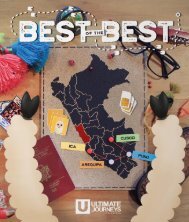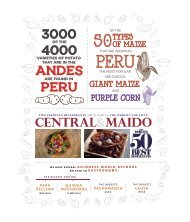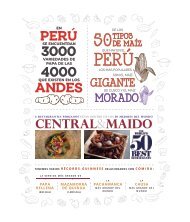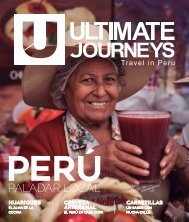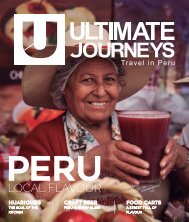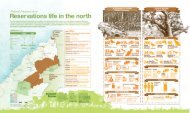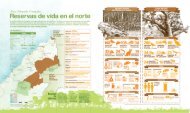UJ#5 Paracas
You also want an ePaper? Increase the reach of your titles
YUMPU automatically turns print PDFs into web optimized ePapers that Google loves.
order to reach humid ground. Soon after, other societies<br />
with other languages and their own unique identities<br />
began to develop, each with its own political structure<br />
and culture.<br />
In the north, for example, the Vicus (V b.c. VIII a.d.)<br />
were polytheists who lived primarily from agriculture,<br />
using copper, silver and gold tools along with advanced<br />
systems of irrigation. Analysing the iconography in<br />
their ceramics, archaeologists have been able to make<br />
some assumptions about their social structures and<br />
beliefs. The Vicus developed a social hierarchy similar to<br />
many societies, with a class of nobles connected with<br />
the government, a military class, a commercial class,<br />
farmers and finally slaves.<br />
The Moche people (I VIII a.d.), who also lived along<br />
Peru’s northern coast, spoke the now-extinct muchik<br />
language. The Moche made enormous advances in<br />
hydraulic engineering, architecture and metallurgy. Their<br />
most impressive constructions were huge pyramids and<br />
religious centres, built using vast amounts of human<br />
labour, to adore Ai apaec, a ferocious god whose<br />
image covers the walls of both the Huaca del Sol and<br />
the Huaca de la Luna, Moche ruins found in the desert<br />
outside of Trujillo.<br />
In the flat, Andean Altiplanos, or high plains, that circle<br />
Lake Titicaca, the Pukarás (I b.c. III a.d..) were the first<br />
people to establish an urban development and to<br />
dominate the hostile environment for animal husbandry<br />
and agriculture. The Pukarás raised cattle and other<br />
animals, and farmed using increasingly successful<br />
techniques which eventually led to the creation of the<br />
Tiahuanaco culture (I a.d-XIII a.d.), one of the greatest<br />
Altiplano civilisations of its period, extending from Titicaca<br />
to what today is northern Chile and southern Argentina.<br />
With their enormous capital city with pyramids, plazas and<br />
monoliths sitting on the southern shores of Lake Titicaca,<br />
the Tiahuanaco spread the image of the mythological<br />
god of the Báculos (thought to be the god Wiracocha in<br />
later, Incan society) across its territories.<br />
Like the Tiahuanaco, other civilisations also built<br />
vast and important cities and ceremonial centres. On<br />
Peru’s southern coast, the Nasca (I b.c.-VI a.d.), who<br />
followed the <strong>Paracas</strong> civilisation, built their political and<br />
religious centre in Cahuachi, a huge urban-ceremonial<br />
complex that is remarkable for the social organization<br />
needed for its construction. In addition to Cahuachi, the<br />
Nasca people also created the so-called Nasca Lines,<br />
mysterious engravings in the desert sands that are visible<br />
only from the air. German Archaeologist Maria Reiche<br />
spent years studying the lines and concluded that they<br />
are part of a sophisticated solar calendar. The Nascas<br />
additionally developed a complex system of aqueducts<br />
in order to grow in the desert sands, expanding their<br />
influence up into the mountains of Ayacucho, where<br />
their contemporaries, the Warpas (I b.c. V a.d.), lived.<br />
From this union of cultures, the powerful Wari Empire (VI<br />
a.d. XIII a.d.) was born.<br />
The birth of the Wari ushered in the Middle Horizon<br />
Period, characterised by a large area of Peru being ruled<br />
from an Andean base. The Wari influence grew to cover<br />
Arequipa’s mountain and coastal region, greater Cusco<br />
to the west, and all of Lambayeque to the north, creating<br />
what is known as the first Andean Empire. After centuries<br />
of social, religious and political control, the Wari empire<br />
collapsed and new, local societies were reborn rich with<br />
ancient knowledge and new technological advances.<br />
The Chimú, Chachapoya, Ischmay, Chanca, Huanca,<br />
Chincha, Quechua and Aimara people were these new<br />
kingdoms which would eventually be incorporated into<br />
the Inca Empire (1438-1533).<br />
From the time when the first people of Peru discovered<br />
agriculture and began to settle, their continuous process<br />
of learning about and dominating their environment is<br />
what allowed them to create powerful nations. Today we<br />
can walk through enormous, ancient cities and imagine<br />
what they must have been like filled with thousands<br />
of people. Farmers and fisherman would have been<br />
carrying their goods to the houses of the nobles, who<br />
in turn would make offerings to the gods and distribute<br />
those goods across the lands to feed the armies of<br />
soldiers who protected the empire and the workers<br />
who supported it. Some fought to help expand the<br />
empire, while others built magnificent works of hydraulic<br />
engineering, increasing the cultivable lands. As we look<br />
back, it is clear that Perú is, without a doubt, the cradle<br />
of Americas´s first, complex societies.<br />
Rodrigo Cabrera<br />
The doorway to Rumicolca:<br />
This ancient aqueduct was<br />
built by the Wari between 800<br />
and 1,000 a.d. and later turned<br />
into a control point by the<br />
Incas.<br />
AFTER ALL, PERU<br />
OFFERED 1.2 MILLION<br />
SQUARE KILOMETRES OF<br />
INHOSPITABLE DESERT,<br />
JAGGED ANDEAN<br />
PEAKS, WINDSWEPT<br />
ALTIPLANO PLAINS AND<br />
THE EXOTIC AMAZON<br />
JUNGLE. IT WAS A PLACE<br />
WHERE, OVER 5,000<br />
YEARS, INCREDIBLE<br />
CIVILISATIONS HAD<br />
BEEN BORN<br />
/71




